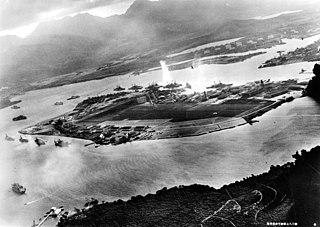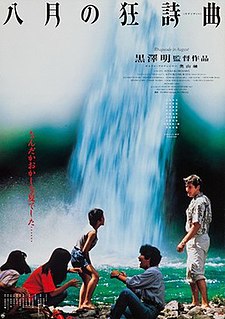Related Research Articles

The Attack on Pearl Harbor was a surprise military strike by the Imperial Japanese Navy Air Service upon the United States against the naval base at Pearl Harbor in Honolulu, Territory of Hawaii, just before 08:00, on Sunday morning, December 7, 1941. The attack led to the United States' formal entry into World War II the next day. The Japanese military leadership referred to the attack as the Hawaii Operation and Operation AI, and as Operation Z during its planning. Japan intended the attack as a preventive action to keep the United States Pacific Fleet from interfering with its planned military actions in Southeast Asia against overseas territories of the United Kingdom, the Netherlands, and the United States. Over the course of seven hours there were coordinated Japanese attacks on the U.S.-held Philippines, Guam, and Wake Island and on the British Empire in Malaya, Singapore, and Hong Kong.

The Bombing of Tokyo was a series of firebombing air raids by the United States Army Air Forces during the Pacific campaigns of World War II. Operation Meetinghouse, which was conducted on the night of 9–10 March 1945, is the single most destructive bombing raid in human history. Of central Tokyo 16 square miles were destroyed, leaving an estimated 100,000 civilians dead and over one million homeless.

Pearl Harbor is a 2001 American romantic war drama film directed by Michael Bay, produced by Bay and Jerry Bruckheimer and written by Randall Wallace. It stars Ben Affleck, Kate Beckinsale, Josh Hartnett, Cuba Gooding Jr., Tom Sizemore, Jon Voight, Colm Feore, and Alec Baldwin. The film presented a heavily fictionalized version of the Japanese attack on Pearl Harbor on December 7, 1941, focusing on a love story set amid the lead up to the attack, its aftermath, and the Doolittle Raid.

Takiji Kobayashi was a Japanese author of proletarian literature.

The USS Panay incident was a Japanese attack on the American gunboat Panay while it was anchored in the Yangtze River outside Nanking, China on December 12, 1937. Like the infamous attack on Pearl Harbor four years later, Japan and the United States were not at war at the time. The Japanese claimed that they did not see the US flags painted on the deck of the gunboat, apologized, and paid an indemnity. Nevertheless, the attack and the subsequent Allison incident in Nanking caused U.S. opinion to turn against the Japanese.

The USS Arizona Memorial, at Pearl Harbor in Honolulu, Hawaii, marks the resting place of 1,102 of the 1,177 sailors and Marines killed on USS Arizona during the attack on Pearl Harbor on December 7, 1941, and commemorates the events of that day. The attack on Pearl Harbor led to the United States' involvement in World War II.

Daigo Fukuryū Maru was a Japanese tuna fishing boat with a crew of 23 men which was contaminated by nuclear fallout from the United States Castle Bravo thermonuclear weapon test at Bikini Atoll on March 1, 1954.

Rhapsody in August is a 1991 Japanese film by Akira Kurosawa based on the novel Nabe no naka by Kiyoko Murata. The story centers on an elderly hibakusha, who lost her husband in the 1945 atomic bombing of Nagasaki, caring for her four grandchildren over the summer. She learns of a long-lost brother, Suzujiro, living in Hawaii who wants her to visit him before he dies. American film star Richard Gere appears as Suzujiro's son Clark. The film was selected as the Japanese entry for the Best Foreign Language Film at the 64th Academy Awards, but was not accepted as a nominee.

Momotarō no Umiwashi is an animated Japanese propaganda film produced in 1942 by Geijutsu Eigasha and released March 25, 1943. Running at 37 minutes, it was close to being feature-length, but it was not the first animated feature film in Asia; that honor goes to China's 1941 Princess Iron Fan, which was 73 minutes long. A DVD version without English subtitles was released in Japan by Kinokuniya Shoten in 2004; one with subtitles was released in the United States by Zakka Films in 2009.

The United States detonated two nuclear weapons over the Japanese cities of Hiroshima and Nagasaki on August 6 and 9, 1945, respectively. The two bombings killed between 129,000 and 226,000 people, most of whom were civilians, and remain the only uses of nuclear weapons in armed conflict.

The Port of Kobe is a Japanese maritime port in Kobe, Hyōgo in the greater Osaka area, backgrounded by the Hanshin Industrial Region.

USS Clay (APA-39) was a Bayfield class attack transport which served with the US Navy in World War II.

Vladimir ‘Val’ Nicholas Ossipoff was an American architect best known for his works in the state of Hawai'i.
Censorship in Japan, although prohibited by the country's constitution, is effectively mandated through the Article 175 of the Criminal Code of Japan with regards to pornography.

Yokohama Specie Bank was a Japanese bank founded in Yokohama, Japan in the year 1880. Its assets were transferred to The Bank of Tokyo in 1946. The bank played a significant role in Japanese trade with China. The original bank building is now the Kanagawa Prefectural Museum of Cultural History. During the Second World War the bank controversially acted as the paymaster for the Imperial Japanese Army as it conquered parts of Asia.

The history of the Jews in Japan is well documented in modern times with various traditions relating to much earlier eras.

Pearl Harbor Aviation Museum is a non-profit founded in 1999 to develop an aviation museum in Hawaii. Part of Senator Daniel Inouye's vision for a rebirth of Ford Island, the museum hosts a variety of aviation exhibits with a majority relating directly to the attack on Pearl Harbor and World War II. The first section of the museum, hangar 37, opened with the museum on December 7, 2006, and features much of the museum's static exhibits. The museum's hangars show damage from the attacks on Pearl Harbor from December 7, 1941.

Ford Island is an islet in the center of Pearl Harbor, Oahu, in the U.S. state of Hawaii. It has been known as Rabbit Island, Marín's Island, and Little Goats Island, and its native Hawaiian name is Mokuʻumeʻume. The island had an area of 334 acres (135 ha) when it was surveyed in 1825, which was increased during the 1930s to 441 acres (178 ha) with fill dredged out of Pearl Harbor by the United States Navy to accommodate battleships.

The attack on Pearl Harbor has received substantial attention in popular culture in multiple media and cultural formats including film, architecture, memorial statues, non-fiction writing, historical writing, and historical fiction. Today, the USS Arizona Memorial on the island of Oahu honors the dead. Visitors to the memorial reach it via boats from the naval base at Pearl Harbor. The memorial was designed by Alfred Preis, and has a sagging center but strong and vigorous ends, expressing "initial defeat and ultimate victory". It commemorates all lives lost on December 7, 1941.

America Maru was the second of three high speed passenger liners built for the Oriential Steamship Company. Converted into an armed merchantman during the Russo-Japanese War of 1904–1905, she played a crucial role in the Battle of Tsushima. Although used as a hospital ship during World War II, she was sunk by the United States Navy in 1944 with great loss of civilian lives.
References
- ↑ IMBD
- ↑ "New York Times: December 7th". NY Times. Archived from the original on 2011-05-20. Retrieved 2008-05-26.